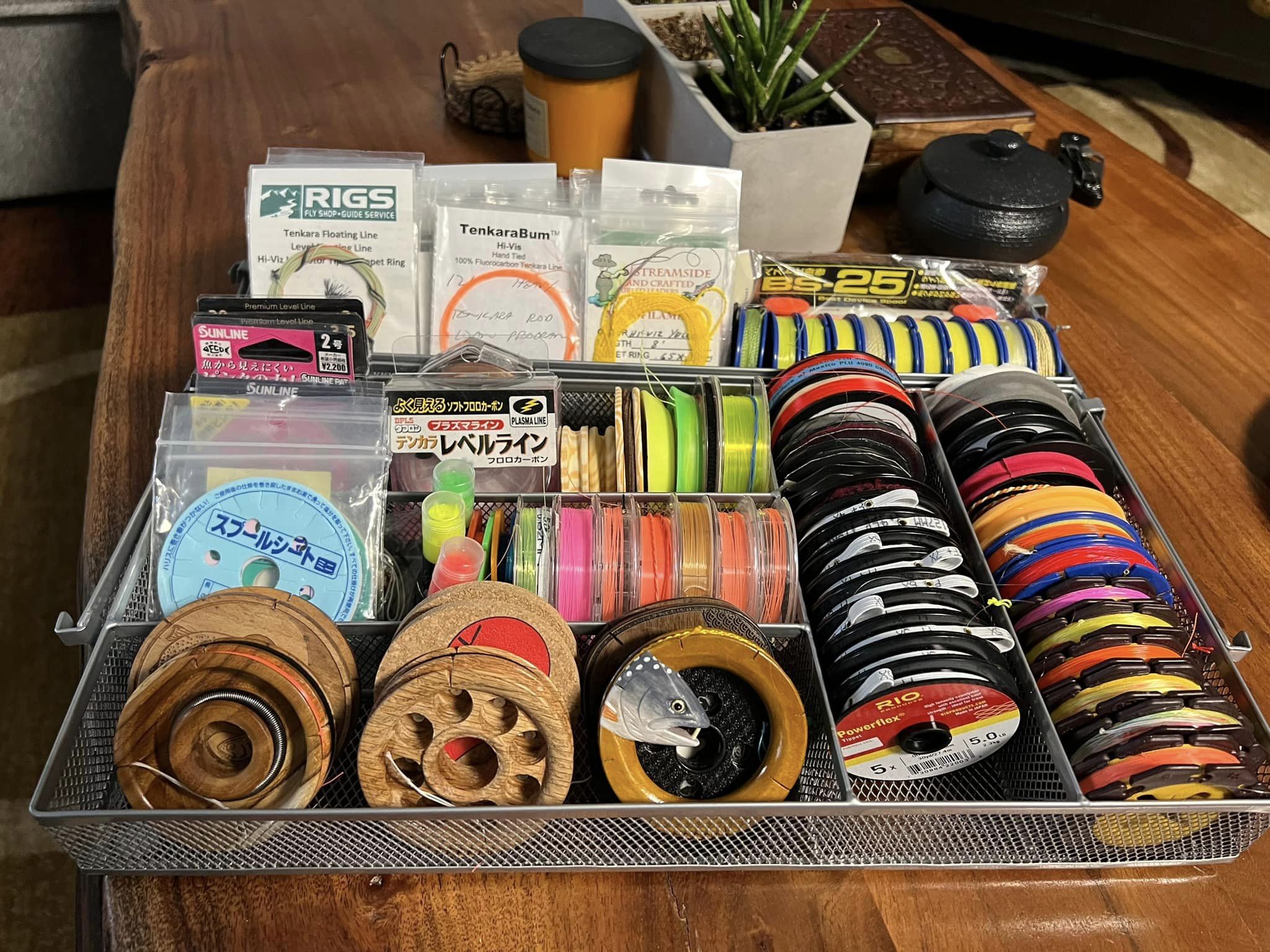
Every angler new to tenkara will inevitably face the age-old question: should I use a level line or a furled line? Often, it’s phrased, “which one is better?” My answer is (of course) it depends. But that answer can seem somewhat dismissive and disappointing. Instead, I thought I’d offer a more definitive answer–outlining the pros and cons of each.
Furled Tenkara Lines
“Furled line” refers to a line which is composed of multiple strands of material furled together (often by a machine or with the aid of a mechanical device) to create taper from thick to thin. There are such things as “furled” level lines, but don’t worry about that right now. For our purposes, we’ll focus on tapered furled lines since those are the most popular.
Traditional lines were made of horsetail or other natural materials, but today, they can be made from a myriad of materials including nylon, fluorocarbon, polyester thread, Kevlar, and more. They’re sold in a fixed length and are finished with some means for attaching it to the rod and tippet such as loops and/or tippet rings.
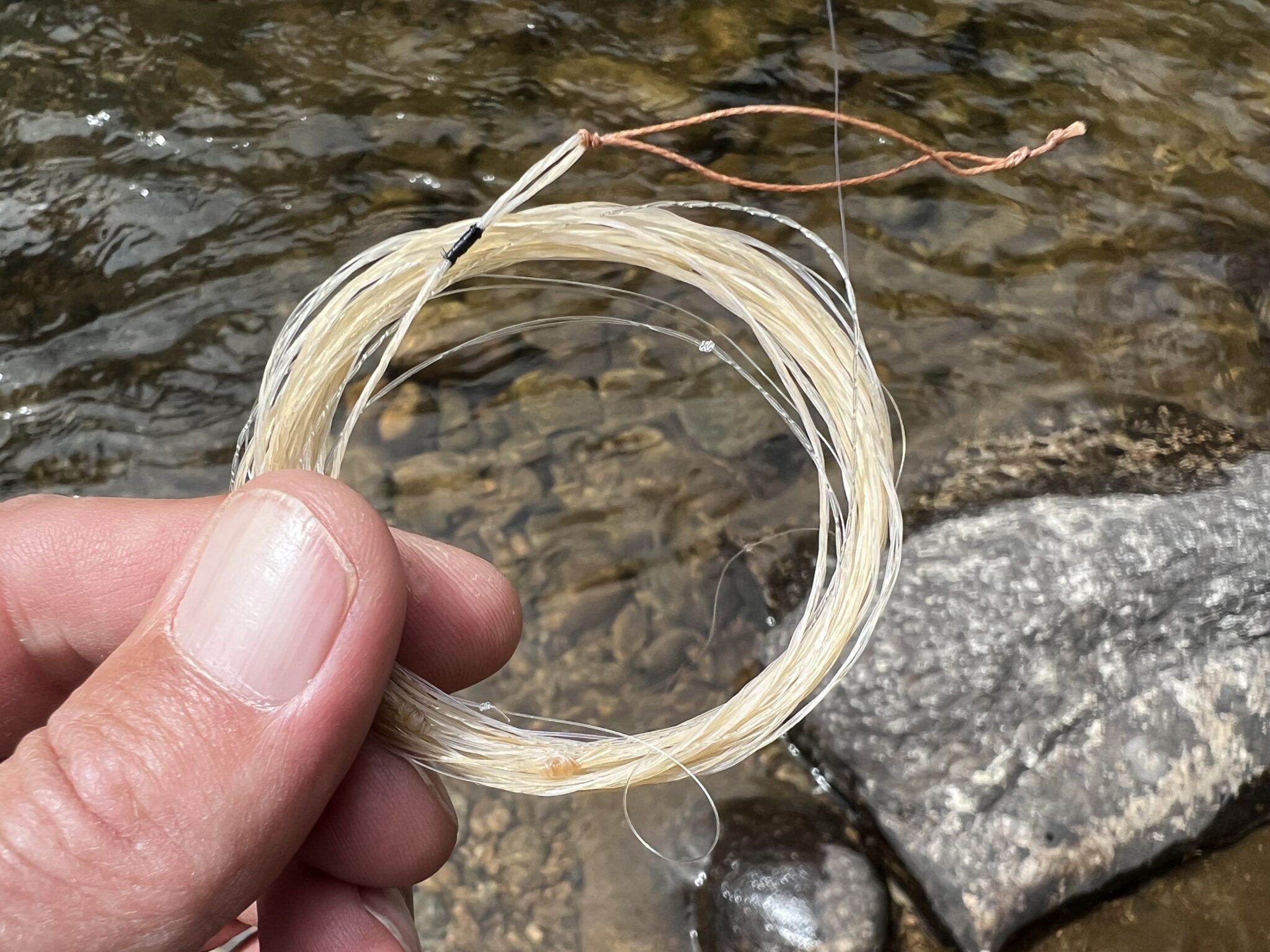
Furled tenkara lines are essentially the same as “furled leaders” used in western fly fishing, except they’re much longer. Whereas a western furled leader may be 9′, 10′, 12′, etc., a tenkara furled line might be 13′, 16′, 18′, etc..
Just as a reminder: there is no “leader” in tenkara like there is in regular fly fishing. There is only the line and the tippet.
Advantages of Furled Lines
Easy to Cast
Most beginners (and even experts) find a furled line the easiest to cast. This is due to two factors:
1. The overall line has a fair amount of mass to it, so it forces the rod to load and unload (bend and straighten out) with little effort. This means the rod does more of the “work” for you so casting feels more “effortless”.
2. The taper facilitates turnover (the line straightening out at the end of a cast). The thicker, heavier line from the butt progressively propels the lighter line in front of it and transfers the energy of the cast forward very efficiently. People often refer to furled leaders as having a “smooth turnover”. Those accustomed to casting western fly lines will especially find the feel familiar. The overall consensus is that tapered, furled lines cast easily for anglers at any level of experience.
Power
Given all of the above, you can probably imagine that furled lines are a popular choice for casting larger or heavier flies. Because of that strong transfer of energy, you have more power to turn over weighted flies.
Visibility
Being made of multiple strands, furled lines are much thicker than single-strand level lines and this makes them intrinsically very easy to see. This is important for beginners so they can track what their line is doing in the air while practicing, but it’s also crucial for strike detection. Since we don’t really use strike indicators in tenkara, visual strike indication by watching the line can make all the difference in the world.
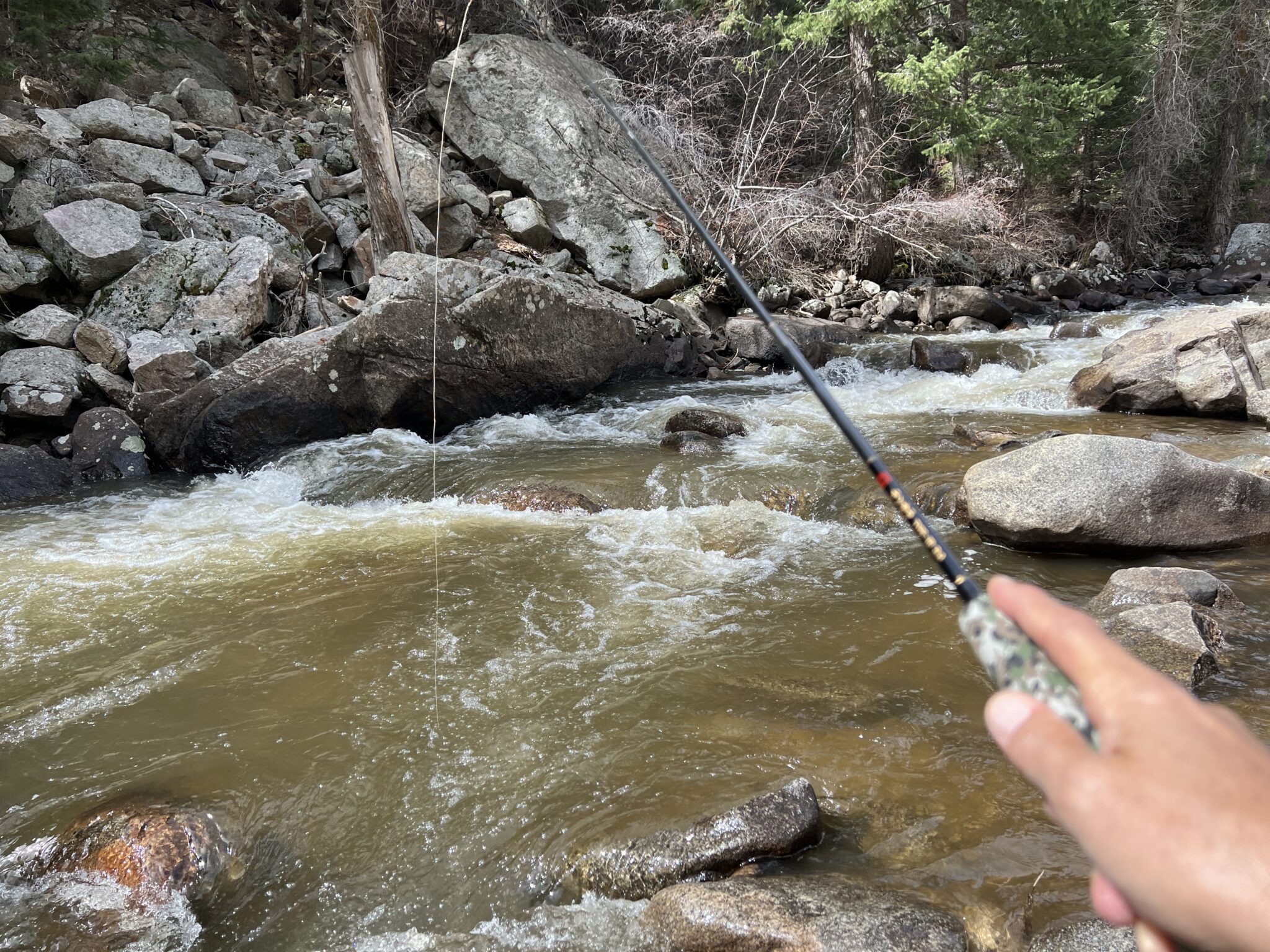
In addition to a larger diameter, furled lines are also easier to see because they’re available in a variety of bright colors (and even variegated patterns with increase visual acuity by contrast.
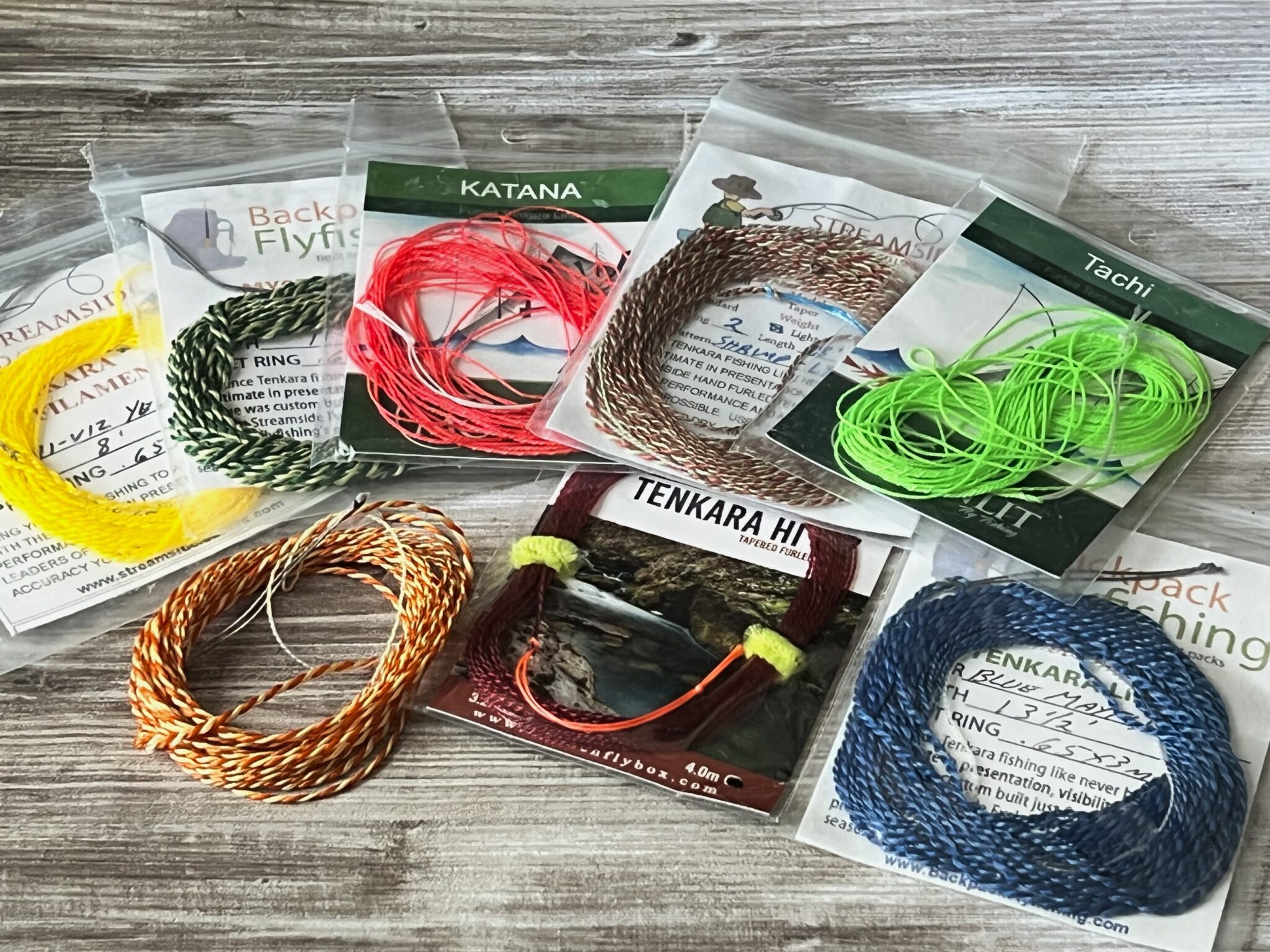
Wind Cutting
There are varying opinions on this: some say furled lines are bad in the wind, some say good. It really depends on the mass-to-bulk ratio. Essentially, it boils down to the choice of material.
For example, if you took two furled lines with exactly the same specs except one were made of nylon and the other were made of fluorocarbon, which one do you think would cut through the wind better? Since fluorocarbon is heavier than nylon, the fluoro one would, right?
Some argue that while it’s true furled lines are heavier, their thicker diameter creates so much air resistance that any mass advantage is negated.
I disagree with this empirically and in my opinion, furled lines almost always cast better in the wind than level fluorocarbon lines.
Early in the American tenkara story, nylon furled lines seemed to dominate. But today, they’re not as popular as people favor the advantages of other materials like PE thread and fluorocarbon for this very reason.
Disadvantages of Furled Lines
Cost
Furled lines aren’t inexpensive. A good one can cost $20-$30 or more. So there’s a more of an upfront investment and a higher cost of replacement than level lines (as we’ll see later). But those who favor these lines feel that the benefits outweigh the cost.
Lacks Delicacy
While furled lines can make a very delicate presentation when cast properly, an errant or ill-formed cast can send the line crashing down on the water hard and every trout in the vicinity to run for cover. But this is usually more a symptom of the caster’s deficiency than the line itself. A skilled caster knows how to make a furled line land softly on the surface–it just takes practice.
Pre-determined Length
If you buy a 13′ furled line, it will always be a 13′ line. You can’t make it longer but you can increase your tippet length (which isn’t always the best option). So, this might mean you have to purchase several lines of different lengths to cover varying situations and that can quickly add up in cost. And if you need to adjust your distance out on the water, this will mean pausing your actual fishing time to switch out the entire line for a more appropriate length.
Line Sag
Because of their mass, it’s not easy to keep your line out of the water to achieve a dead drift. For some, this is a non-issue and it certainly isn’t an issue in any situation where it’s OK or even an advantage to keep your line on the water (e.g.. in windy conditions, long, flat pools, or stillwater). For others, it’s a dealbreaker. A lot of it really depends on which type of presentation you want to make and the conditions at hand. But the takeaway is that some people don’t use furled lines simply because they sag and create drag on the line which leads to an unnatural presentation.
Spray
Furled lines capture water in between the strands which can then spray when you cast and potentially scare fish. Some people suggest coating the line with floatant but it doesn’t really do much to prevent spray and it wears off quickly meaning it has to be reapplied multiple times (which is another distraction from fishing time). The remedy for this is to make a false cast or two away from your target to get all the water out before making your final presentation to the fish.
Easily Ices Up
In addition to spray, any water retained between the strands will also freeze, impeding casting. While this is true of pretty much any type of line, furled lines are especially susceptible since the water isn’t just a coating on the surface of the line, it’s soaked in. There are products out there to combat this such as Stanley’s Ice Off paste, but in my experience, none of them really work well. Unless you fish in freezing temperatures often, this isn’t a huge problem.
Level Fluorocarbon Lines
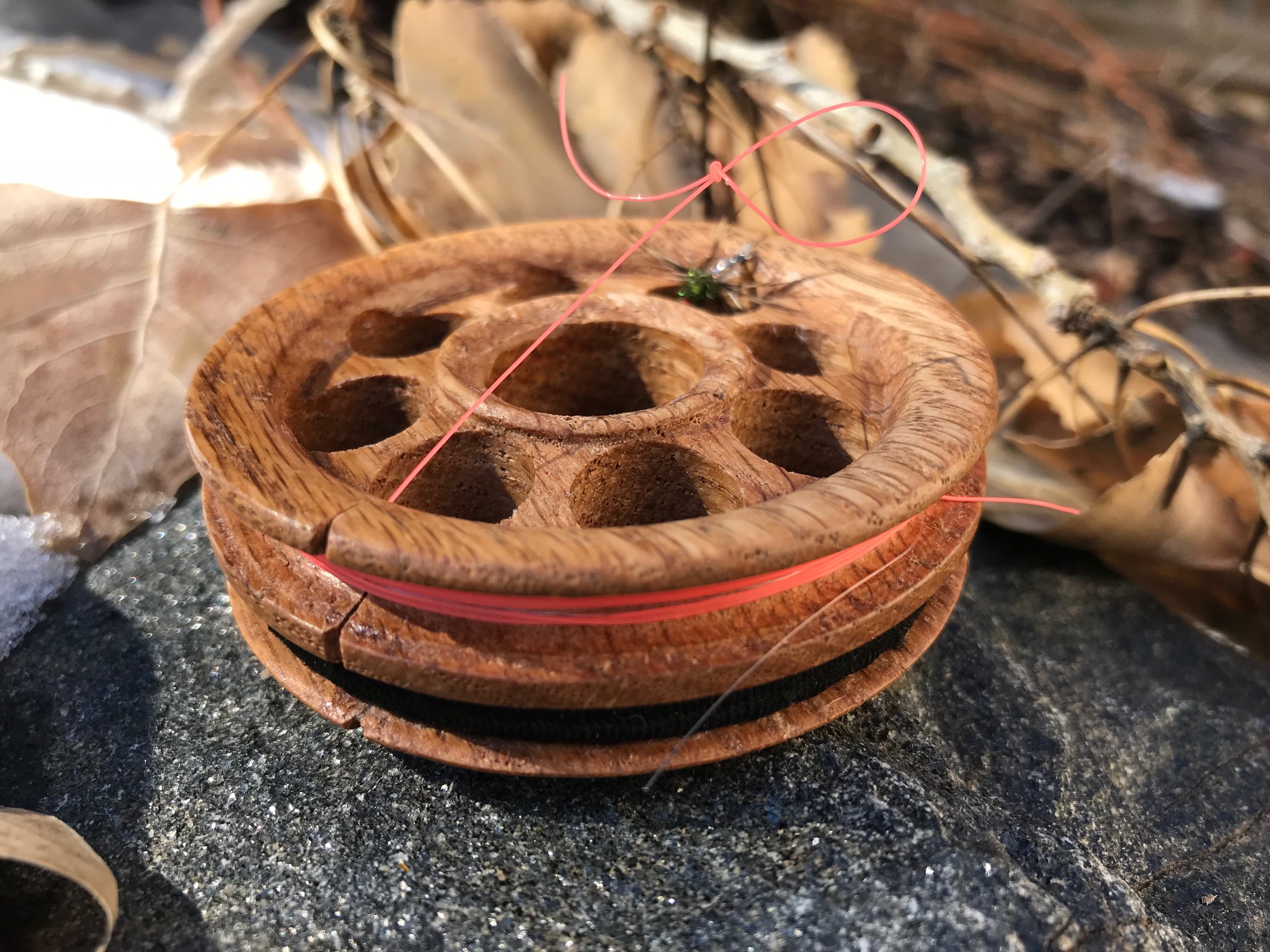
Notice I specifically used the word “fluorocarbon” in the heading above and not just “level lines”. That’s because when most tenkara anglers use the term “level line” they’re referring specifically to a monofilament fluorocarbon line, not nylon, co-filaments, PE braids, or other materials. All of those lines exist and are, indeed, “level lines”, but the most commonly understood definition of “level line” is a single strand of fluorocarbon that maintains its diameter throughout the length of the line. And that’s the definition we’ll use moving forward.
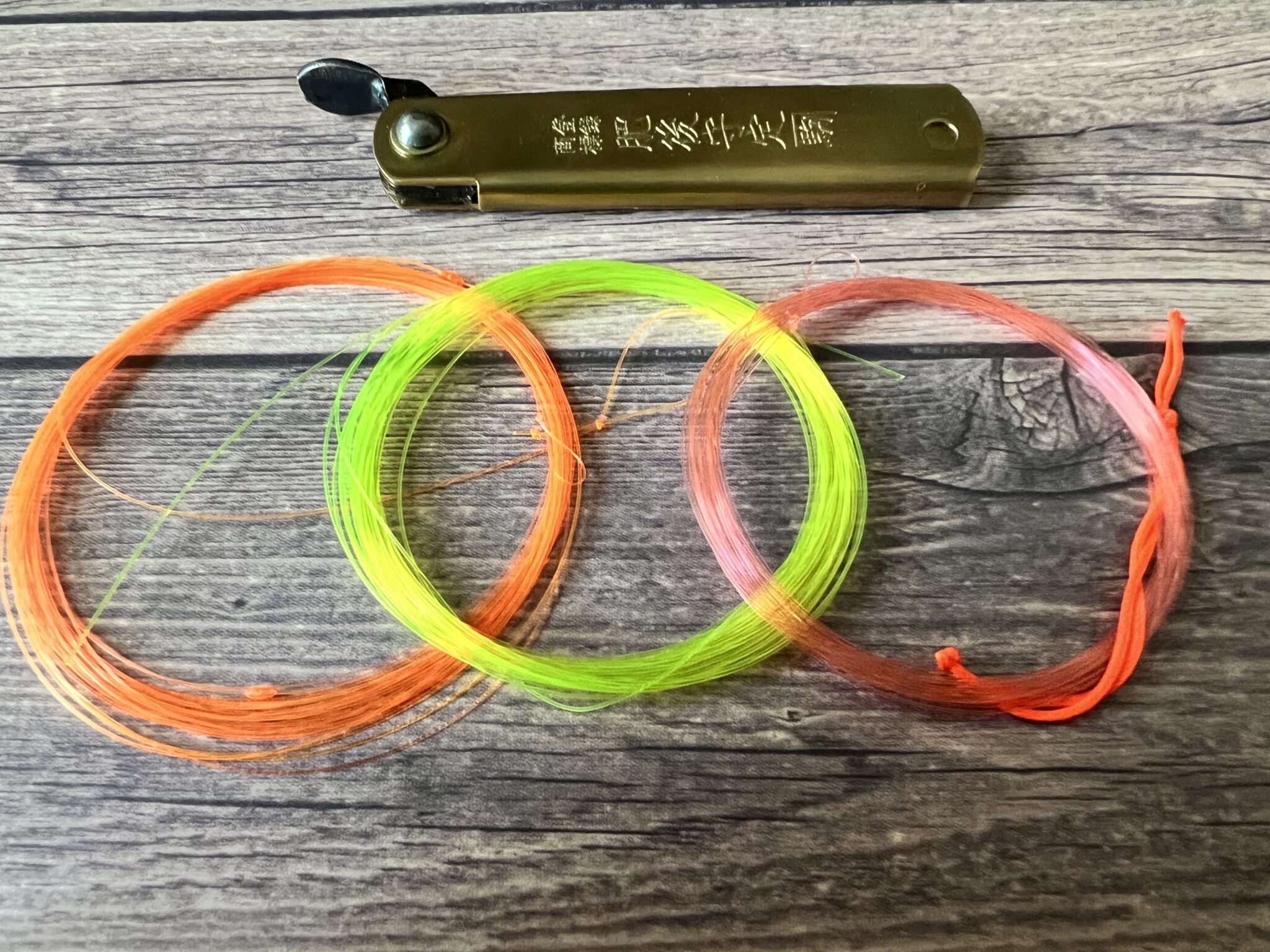
Many people ask if they can just use fluorocarbon from Cabela’s, Bass Pro Shops or their local tackle shop that’s meant for spinfishing or baitcasting (because it’s cheaper than tenkara-specific fluorocarbon). The answer is yes, but with two caveats:
- Many fluorocarbon lines for spinfishing and baitcasting say they’re “fluorocarbon”, but they’re actually fluorocarbon coated, usually with a nylon core. But tenkara level lines are 100% fluorocarbon, not just coated. Why does this matter? Mass! Fluoro is heavier than nylon so obviously, something that’s made completely of a heavier material and not just coated over a lighter material is going to cast more easily (the same reason furled lines are easy to cast). Manufacturers coat the line because it’s cheaper than making the line pure fluorocarbon (yet it allows them to still use the buzzword “fluorocarbon” for marketing). Remember, that that line at Cabela’s is designed to be cast with a heavy lure or sinkers. The heavy weight of the lure pulls the line out. But in tenkara, we’re doing the opposite. The line is responsible for carrying the light fly out so more mass helps. I highly recommend buying a line specifically intended for tenkara. You’ll be glad you spent a few extra dollars. And aside from a catastrophe, they can last a very long time. I have a few level lines that I’ve fished with for several seasons and they’re still in near-perfect condition!
- Fluorocarbon line for conventional fishing is almost always clear (or sometimes dyed a dark green or some other “stealth” color). This means it will be hard to see. Conversely, tenkara level line is almost always dyed a bright color for better visibility. Tenkara level lines are more expensive (in part) because fluorocarbon is more difficult to dye than nylon. But in my opinion, the added cost is absolutely worth it. There are things you can do to increase a clear line’s visibility like this, this, this, or this, or, you could add a conventional strike indicator (which will ruin your cast) but why try to make something be something it’s not when the ideal solution is so readily available? Here’s a picture of some conventional fluorocarbon line (top) and some tenkara level line. Which one would you rather fish with?
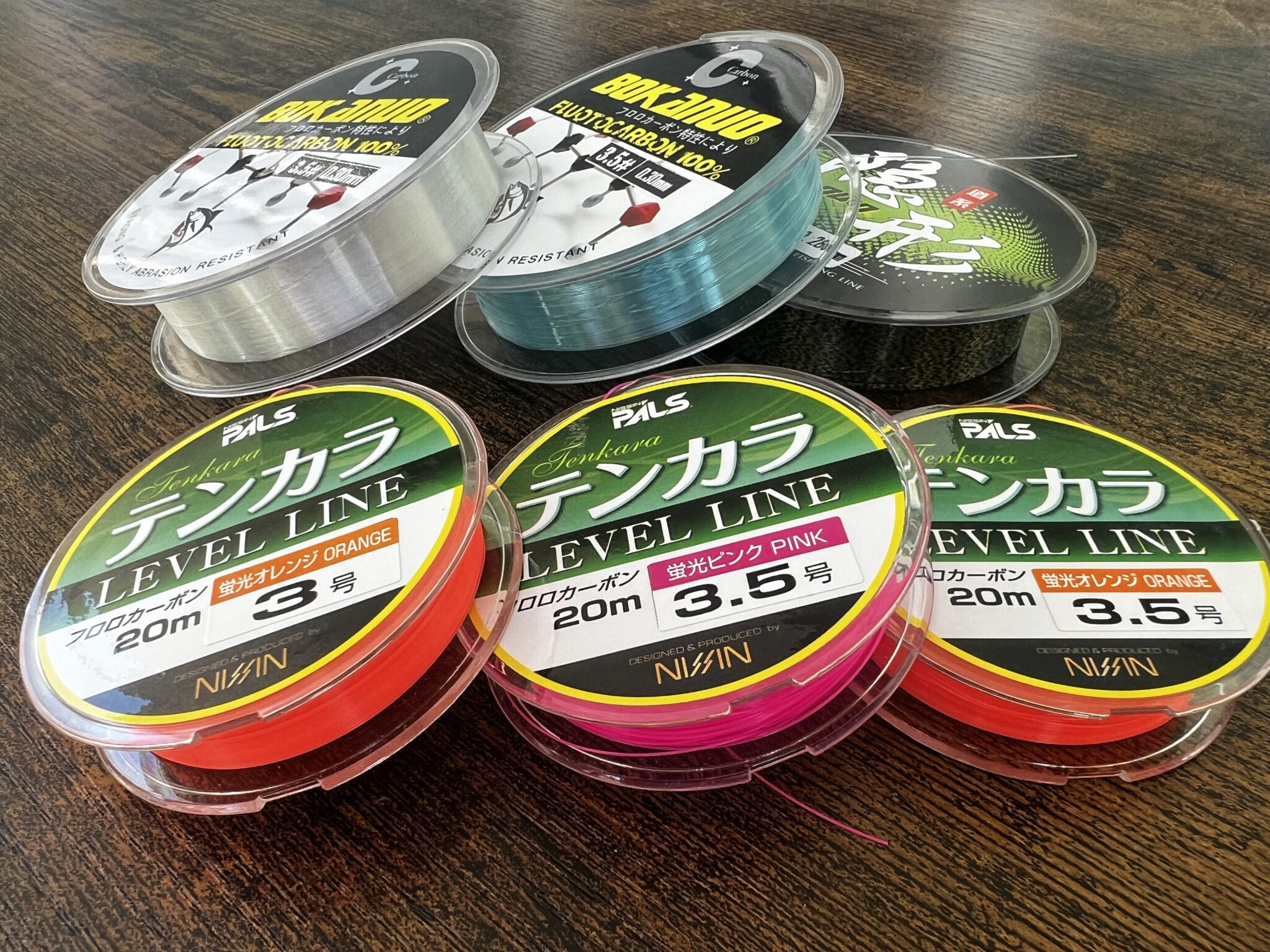
Side note: A common misunderstanding it that the word “mono” refers to nylon. But that’s not the case. Both nylon and fluorocarbon can be single stranded “monofilament” line.
Now that we have a common definition and understanding of “level line”, let’s look at them in more depth and explore their strengths and weaknesses.
Advantages of Level Lines
Delicacy
Probably the first thing you’ll hear about level line is that it’s delicate. Because it’s so thin (let’s say 0.30″ for example), it lands on the water gently which is a great advantage when you need a stealthy presentation to skittish trout. Next to tenkara level line, a typical western fly line looks like a telephone cable. And as you probably know, delicacy in presentation can make the difference between hooking the fish and sending it running for cover. Whereas furled line might take a little practice to achieve delicacy, level lines, by nature, offer a smooth landing right out of the box.
Versatility
Since fluorocarbon has a somewhat neutral density, it can be fished for both dry flies and wet flies. Essentially, the line will do whatever you want it to do. If you want it float with a dry fly, it will float. And if you want it to sink, it will follow a wet or weighted fly down. This gives you streamcraft economy, avoiding the need to change lines based on fly choice and where you’re fishing in the water column.
Adjustability
Fluorocarbon level line usually comes on a spool of 30M or more, which means you can cut it to whatever length you want. Plus, if you’re fishing let’s say a 13′ line but need a little extra reach, you can cut a few feet off your spool and easily tie it on to increase the length. And the opposite is true too. If your line is too long, simply cut it down to the desired length. This is in juxtaposition to furled lines which cannot be lengthened or shortened and as we learned above, will require you to stop fishing and re-rig.
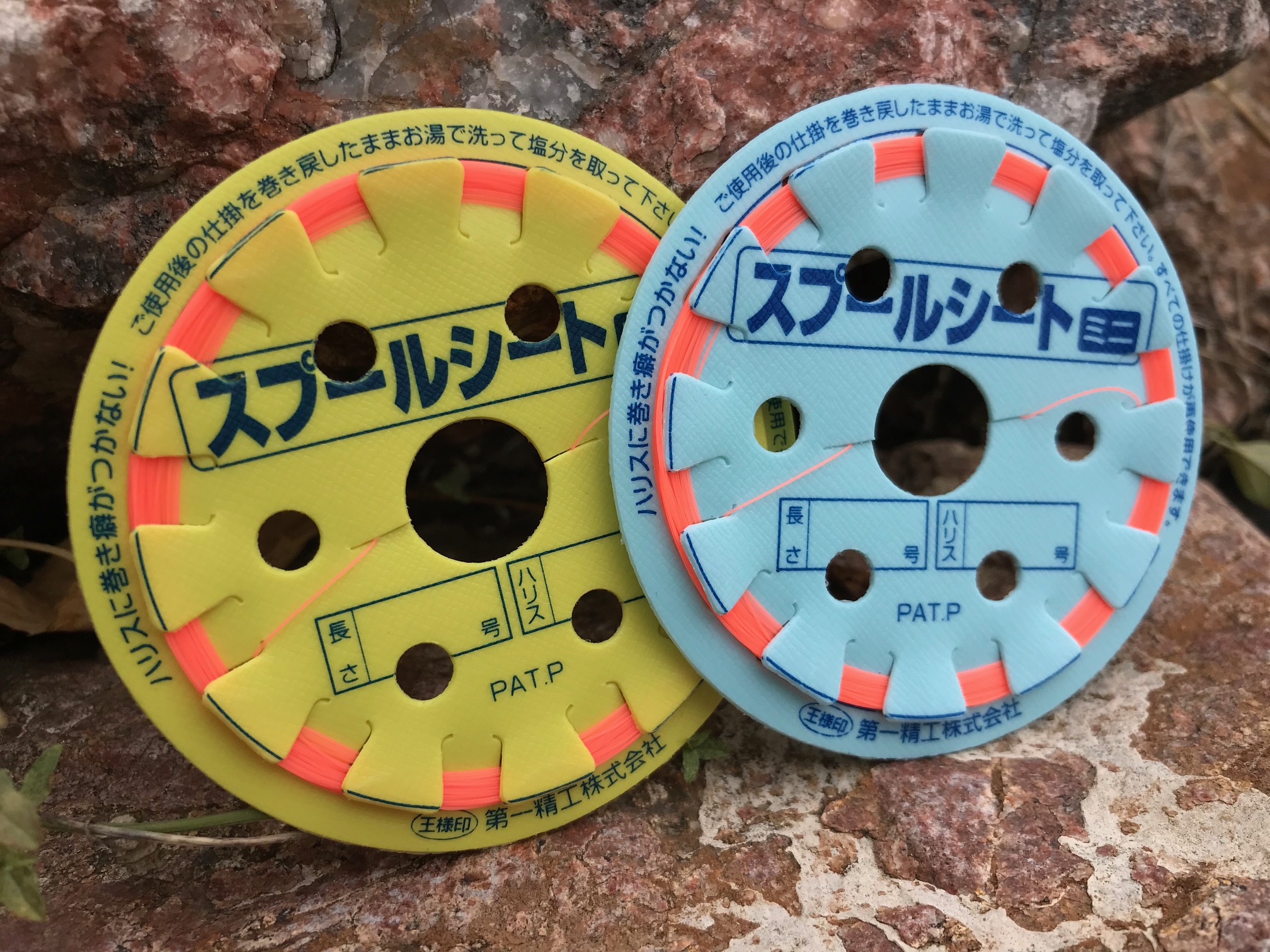
Value
In general, level line is cheaper. We know that furled lines are a fixed length. If you buy a 12′ one, it’ll always be just one 12′ line. But from one spool of fluorocarbon, you can usually make at least two or more lines for about the same cost or less than one furled line. Also, if the line gets worn out or destroyed, it’s relatively inexpensive to replace.
Strength
Some people look at level line and question its strength. But even the lightest level line is probably 20-lb. test or so and given the great tippet protection the longer lengths tenkara rods provide, it’s a non-issue. In terms of lbs. test, your tippet will break long before any level fluorocarbon line ever will.
Expendability
This might be hard to imagine being an advantage, but which would you feel better about losing to a snag: a $30 furled line or $6 worth of level line? I have an expensive horse-tail furled line from Japan I ruined the first time I took it out. Now, I wouldn’t even consider bringing one anywhere where there are lots of trees or other snags. But I have no problem throwing a level line there. That’s an advantage because it gives you the confidence to cast into the snaggy places fish favor without worrying about destroying an expensive line.
Disadvantages of Level Lines
Memory
Fluorocarbon can look like a Slinky when you pull it off the spool. You don’t want this because it creates all kinds of headaches like more tangles, excess slack that inhibits strike detection and good hooksets, lack of accuracy because of wind resistance and reduced energy transfer, etc.. Luckily, you can easily straighten it out by pulling it through your thumb and finger along the entire length of the line. You could also buy or make a leader straightener (which is usually just two pieces of rubber between which you pull the line rather than through your hand), but I don’t find them necessary. Here’s a great article on how to straighten your tenkara line.
Wind Resistance
While its light mass is an advantage above in terms of delicacy, it’s also a disadvantage–in the wind. It’s just not heavy enough to defeat moderate breezes as well as a heavier furled line. So if you fish in a place where high winds are prevalent, fluorocarbon level lines may not be your friend. Most of the streams I fish out here in Colorado are in canyons which often give great wind protection. However, out in the wide-open meadow streams, or lakes, wind is never a question. It’s a guarantee. In those cases of course I prefer something with more mass such as a furled line to cut through the gales. Here are some tactics tenkara experts recommend to deal with wind.
Note: No tenkara rod will ever cast in the wind as well as a western fly rod with thick, PVC fly line. So it’s not fair to compare the two. And of course there are those days that are so windy, no rod of any type would cast well. But I’ve found with enough practice, the right rod, and the right line, you can greatly reduce wind’s influence.
Ease of Casting
The reaction most people have when they first see a level fluorocarbon line is that it must be impossible to cast because it’s so gossamer. And this is especially true for those who have a background in western fly fishing and are accustomed to much thicker lines. I know because I felt exactly the same way when I first saw one! And I won’t lie, it took practice. Not an inordinate amount, but a little. If you practice enough, you’ll eventually get it and once you do, you’ll be glad you can take advantage of the pros I listed above. And in time, you’ll be able to cast a level line as easily as a furled.
Visibility
You’ve probably already imagined that level fluoro line could pose visibility issues at a distance. Since many techniques in tenkara involve watching the tip of the line for strike detection, and level fluorocarbon lines are so thin, they can be difficult to see at distance. For some, this is a non-issue, for others, it’s a dealbreaker.
Can you see the level line in this picture?
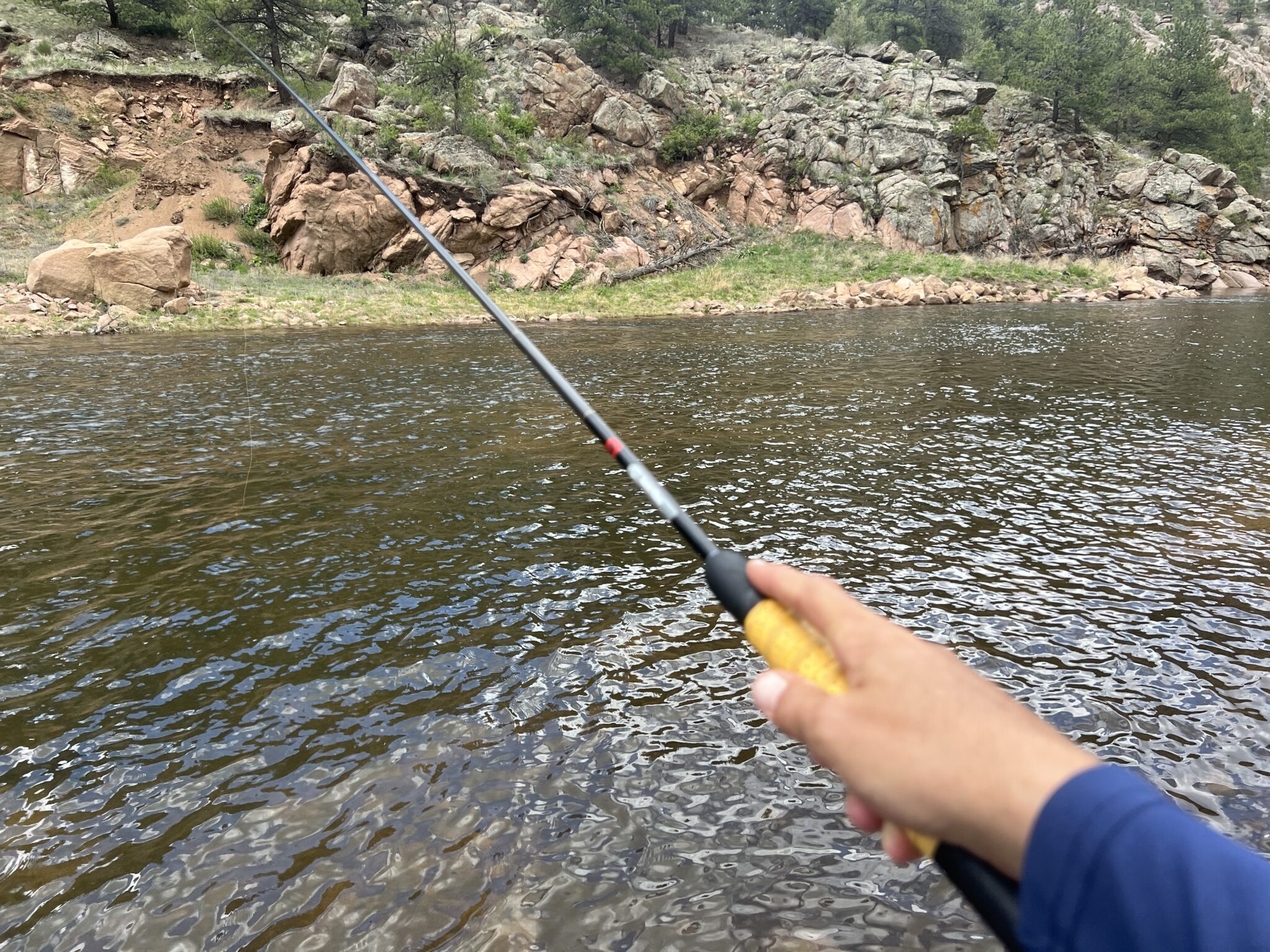
How about this one?
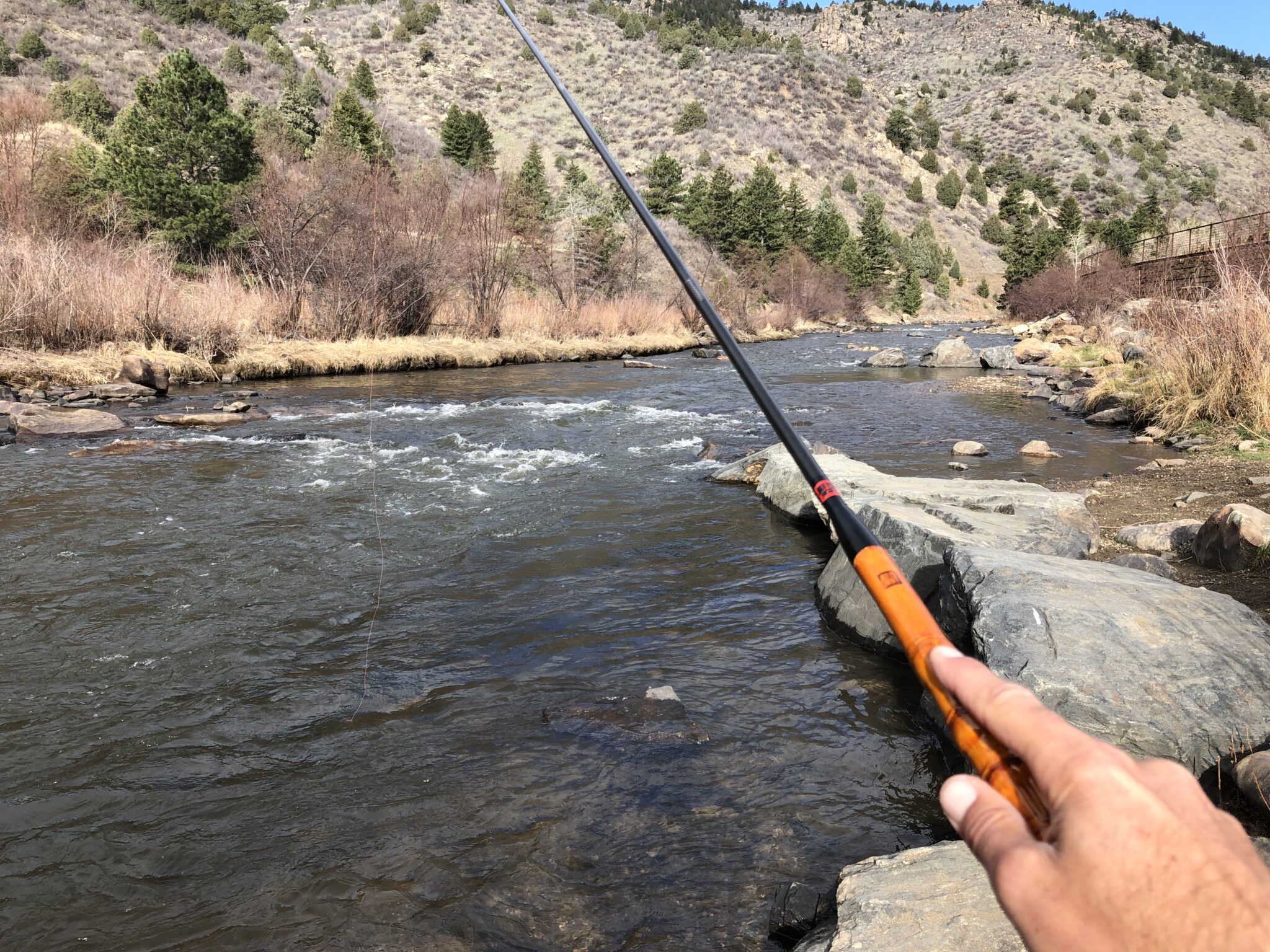
Even though they’re brightly colored, as you can see above, things like lighting, water color, and glare, all affect visibility, and one color might be easier to see than another in different conditions.
But one thing that’s noteworthy is that while most tenkara level lines are dyed, they’re also transparent. I’ve found that, for me, opaque lines are much easier to see. It’s all personal preference and the only way to know what works best for you is to try them out on the water. You might find that one color might be hi-vis in lighting condition A but disappears in lighting condition B. But a different color will be visible in B. You’ll figure out which colors you see best by simple experimentation and deduction. Some people I know actually carry a couple of different colors to cover changing light.
While there are many different types of strike indicators you can attach to the line (which is beyond the scope of this article), I encourage you to try to stick to tenkara’s ethos of simplicity and learn how to track the line by relying on your skill rather than extra gear.
So, which line should you choose?
As with learning any new sport, you don’t know what your preferences are yet. So I recommend getting both level line and a furled line, cast the hell out of both of them, and find which one works for you. And you may find that rather than one over the other, you like both in different situations. I believe the best way to figure anything out is empirically. So I’d much rather have you disregard everything I’ve written above and just try them out for yourself than take everything I’ve said as dogma. No chart, statistics, or advice from experts could ever replace your own experience. All they can do is serve as guidelines to help inform your decision.
What I use and why
There are all sorts of other types of line out there (even titanium ones) and I’ve tried pretty much all of them, yet I find myself always coming back to level line. I typically use a #3.5 but will fish a #3 or #4 if that’s not available. And don’t worry about using a level line that’s in a “heavier” size. Like I said, even the thickest tenkara level line will still be more delicate than the lightest western PVC line.
People obsess about casting the lightest line possible (think #2) but I’ve found there is no significant difference in delicacy between even a #2 and a #4 as long as your cast is good. I’ve never once been in a situation where I was fishing, let’s say a #4, and thought it would make a difference to switch to a #2.5. If it did, that would mean there’s a problem with my presentation, not my line.
You will hear that a heavier level line is easier to cast. And this may be true for absolute beginners. But after some experience and once you figure out your casting style, you’ll see that you can cast a thinner line just as well as a thicker one.
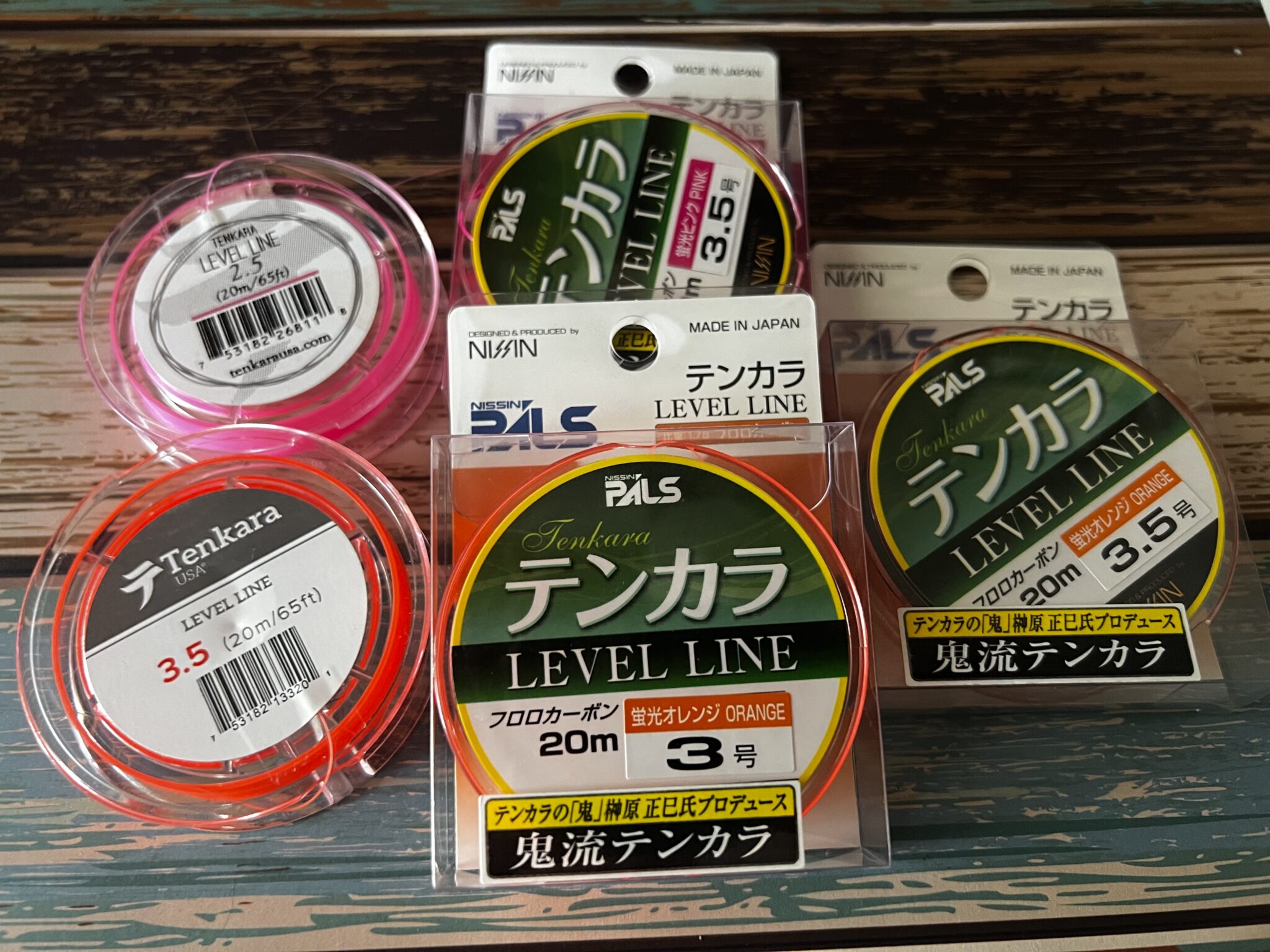
In terms of visibility, as I mentioned above, I prefer opaque rather than transparent lines. And orange and pink are the colors my eyes can apparently best track. I mostly use either a Tenkara USA line or a NISSIN PALS Oni Line which are identical. There are many good lines out there, but after years of experimentation, there are the ones I’ve settled on.
Where to buy tenkara lines
Today, there are LOTS of place to by any kind of tenkara line you can imagine. Visit my tenkara links page under the “Gear Sellers” section for a comprehensive list of where to browse and buy lines. All of of the companies I’ve listed are reputable and offer high-quality lines and I have personal experience with almost all of them so I give them my full recommendation.
Practice!
By now, you should have a good understanding of what furled and level lines are, the differences between them, their pros and cons, and where to get them. The rest is up to you. While the subject certainly extends beyond what we’ve explored here, at least now you now have a good foundation to make informed decisions about how best to experiment and figure out the right line(s) for you.
I recommend practicing in the backyard even if it’s just for a few minutes after dinner a few times a week. Set up a target like a plate to practice accuracy, then graduate to a teacup after you start getting better. And, switch up the distance of the target too. In the real world, not every fish is going to be exactly 20 feet away from you!
Regular practice at home will greatly increase your learning curve so once you’re actually on the water you can focus more on fishing than practicing. But keep in mind that all the backyard practice in the world only tells you how the line casts, not how it fishes.
The true test is on the water. Can I see the line? How easy is it to make the presentations I want with it? Am I getting the fly where I want it go? How well does it match the rod I’m using? Does it feel too heavy or too light? On the stream, you might actually find the line you loved in practice just didn’t work in application. Or vice versa. But this type of deduction is exactly the process that will help you find the lines you’ll love that will make every experience on the water more enjoyable.









Excellent and very helpful article on lines. Good ideas on practicing casting too!
Thank you Jason!
One of the best tenkara articles I’ve read. I’m new to tenkara and have been wondering what line to use. I assumed it would resemble the fly line on my traditional reels. Very helpful. Thanks.
thank you for this excellent content! it helped me a lot as a beginner. especially since you relate the tech to “old school” spin fishing.